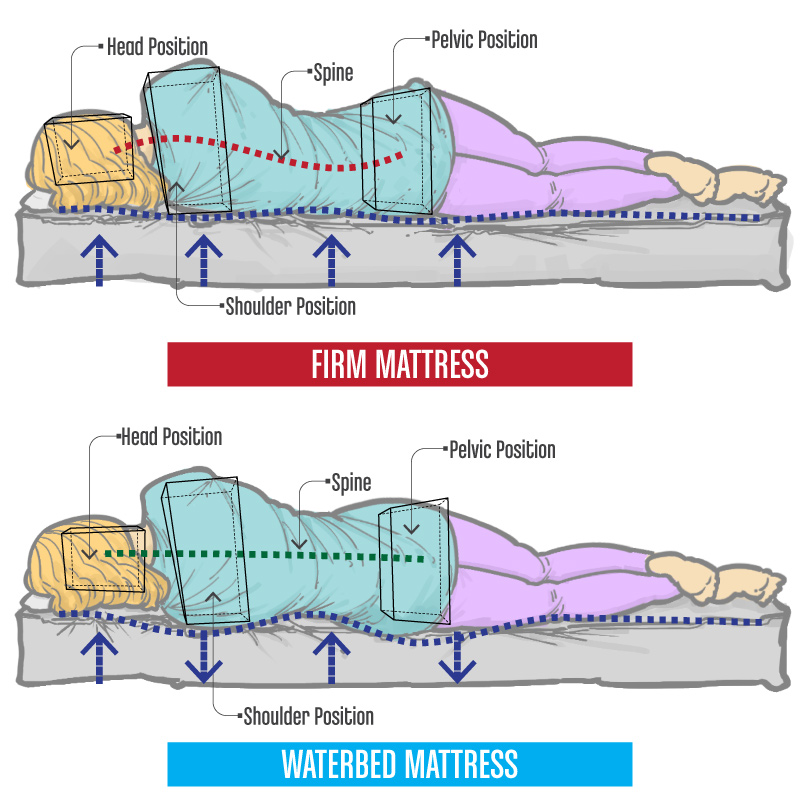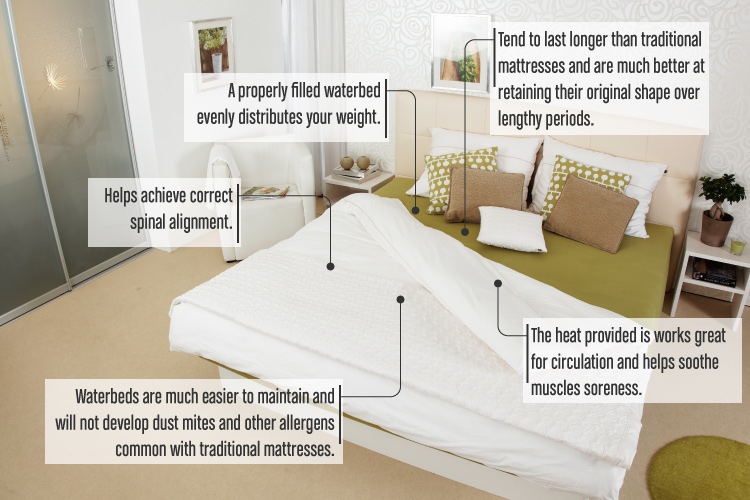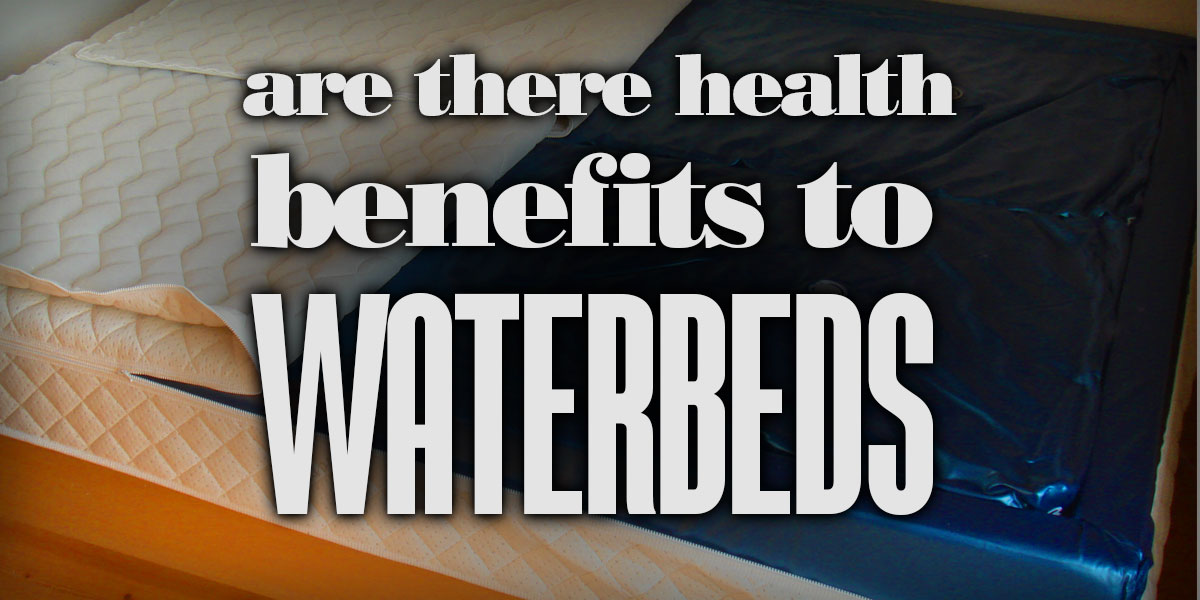When we think about mattresses in the current market, the obvious reigning champs are the classic spring design and memory foam. But it wasn’t too long ago that a third type captivated a curious public and found a home in bedrooms around the world. You may be surprised to learn that we’re referring to waterbeds. Though using water as a filler may sound impractical, their popularity is well documented and remembered.
Though they have since fallen out of fashion, the question remains: are there any health benefits to using waterbeds? Absolutely! The form-fitting nature of waterbeds makes them great for pain relief in the joints and spine while helping prevent bedsores. Plus, the lack of a fabric exterior helps prevent skin and allergy issues that can arise with traditional mattresses.

Before we get into more detail about these benefits, we need to take a look at its history and reputation to understand the waterbed’s strange rise and fall in popularity. We’ll also explore everything you need to know about waterbeds to determine if they’d make a good fit for you and your lifestyle.
The Bed We Know
The waterbed, as most people know it, was designed in 1968 by student Charles Hall at San Francisco State University. Hall’s goal at the time was to create furniture that went against modern conventions, focusing on comfort over style. He wanted to build something that would fully support the user without creating undue pressure points. While popular furniture at the time had elaborate visual designs, it was often uncomfortable when used for long periods.
After experimenting with different types of fillers, Hall settled on using water. The design he ultimately used for his thesis was a vinyl mattress-like bladder. It proved to be a hit with fellow students (its popularity was no doubt helped by Hall heating the water, adding another dimension of comfort to his bed).
In the next three years, Hall refined and patented his design. The biggest change was the addition of a dial to control the heat of the water inside. A-frame was also added to help the mattress maintain its shape. The waterbed was launched as an exciting, albeit experimental, way to achieve a night of more restful sleep.
But then a strange thing happened that would prove to be both the waterbed’s boon and bane. Retailers began selling the new bed largely on sex appeal. Ads often featured happy couples and double entendres implying that sex was simply better on a waterbed, and this angle worked surprisingly well. Having entered the market at the tail-end of the Sexual Revolution, young adults, in particular, were happy to accept the new mattress with open arms. Over the next twenty years, waterbeds would hold one-fifth of the mattress market and become a prevalent wink and a nod in popular culture.
Early 90’s
By the early 90s, however, the bed fell out of fashion and, unable to escape the marketing tactics that once made it so famous, became a symbol of a bygone era. If there were any benefits to using waterbeds, most people were either unaware or didn’t care. They were nothing more than a reminder of a different time.
Though Hall gets the credit for popularizing the waterbed, he wasn’t the first to make one. In the 1800s, European doctors independently designed what is currently believed to be the oldest waterbed. One of the first, made by the Scottish doctor Neil Arnott, was planned specifically for hospital patients who had difficulty moving (or couldn’t move at all). Dubbed the “hydrostatic bed” by the man himself, it aimed to prevent bedsores. Those who followed in Arnott’s wake either made (unknowingly) similar designs or retooled his own for different medical purposes. These included treating ulcers, arthritis, and promoting better blood circulation.
While they were popular in the medical community, these early waterbeds failed to catch on with the public despite being marketed to consumers in large cities. The most common complaint was that water temperature couldn’t be regulated, forcing the user to frequently change the water to maintain any therapeutic effects. Hospitals on both sides of the Atlantic would continue to experiment with waterbed designs through the first half of the 1900s. However, they were used almost exclusively in dire medical cases, so they remained unseen by a large portion of the public.
Unique Problems
Before we delve into how waterbeds can be beneficial, we must first go over the problems they can pose and the difficulties they create. Hall’s waterbed didn’t vanish simply because of the passage of time and changing attitudes. With technology making serious leaps and bounds in all industries, changes occurred in mattresses that made the waterbed seem antiquated and impractical.
First and foremost, waterbeds proved to be expensive to repair. While the first thing that comes to mind is the mattress itself springing a leak, designs improved over time so that this became a less common occurrence. The real problem was with fixing the heating mechanism, a device that was simple enough to use but required specialized parts to repair if something went wrong. It was unlikely that the majority of consumers would have the knowledge needed to make these fixes as well, requiring the attention of a specialist.
The heating units were also expensive to run every night. Meanwhile, during power outages they couldn’t be used at all, leaving the water in the bed cold.
More than anything else, though, waterbeds were a heavy investment of time. Moving the bed required it to be drained and disassembled before being reassembled and refilled in a new location. Repairing leaks wasn’t a simple matter of taping up a hole and adding some more water: the entire mattress had to be drained first. Upon refilling, the heating process would need to run for a while to achieve the right temperature again.
Challenges
Besides issues unique to waterbeds, they also took more simple problems and complicated them. Fitting a sheet could be a challenge, even when using a properly sized frame because water displacement would cause the mattress to change shape.
Anyone simply looking for a nice place to sleep would be blindsided by the costs of operation and maintenance. Though new designs and add-ons were soon introduced to lower the impact of these problems, it wasn’t enough to maintain the incredible growth waterbeds had seen previously. Though they didn’t vanish completely, they languished throughout the 90s and early 2000s.
Most waterbeds you’ll find on the market these days are vastly improved over those in the past, especially in terms of stability and firmness. These designs feature layers of fiber between the water compartment and the exterior vinyl. Old complaints that waterbeds are too soft or offer poor support no longer apply.
Benefits
Waterbeds have a handful of demonstrable benefits. The first is relieving and even eliminating pressure points, just as Hall wanted with his very first design. If you find yourself tossing and turning throughout the night due to concentrated pain in your back, shoulders, or joints, you’re experiencing pressure points caused by the way your mattress supports your body and compensates for your weight.

This problem, though usually associated with spring mattresses, is also common with foam. A mattress is meant to provide support as you rest on it; so while you’re pushing down it’s pushing back against you. The parts of your body that are pressing down the most feel greater resistance and generally suffer more.
A properly filled waterbed evenly distributes your weight, preventing this problem. Generally speaking, this means that they are firm, but for most people, that’s actually a good thing and helps achieve correct spinal alignment. On a similar note, waterbeds tend to last much longer than traditional mattresses and are much better at retaining their original shape over lengthy periods.
Second, the heat they provide is great for circulation and helps soothe sore muscles. Athletes and those with physically demanding jobs may find the added warmth not only relaxing but therapeutic as well.
Finally, waterbeds are much easier to keep clean. The vinyl exterior doesn’t trap oil or dead skin cells from your body, and without those building up, it won’t develop dust mites and other allergens common with traditional mattresses. Though some designs may include layers of fabric inside, the vinyl keeps them protected. Cleaning is a simple matter of wiping with a damp cloth and drying with a towel.
Other medical claims have been made about the benefits waterbeds have, but there isn’t much evidence to support them. As always, it’s best to keep your expectations tempered when buying a new bed.
Misconceptions About Waterbeds
Since losing prominence in the public eye, many complaints and concerns about waterbeds have become accepted as fact. Many of these are based on poor experiences with early models while others are simply not true. Here’s a list of the most prevalent ones and the reality of what they describe.

Waterbeds are difficult to get into and out of.
Waterbeds can be classified as either hard-side or soft-side. As the names suggest, the key difference between the two is in construction. Hardside is called such because it’s designed to be placed within a box-like platform; whereas soft side can sit freely on a bed frame (assuming the frame provides enough underside support).
Hardside can be difficult to easily get into and out of. Coincidentally, they were also the most common model during the bed’s heyday. Understandably, early buyers who had a bad experience would attribute to the bed in general and not the specific build.
Buyers by and large don’t report the same problems with soft side beds; and in the years that have passed add-ons have been made to make hard side beds more accessible and appealing.
The movement of water is disruptive to you or your partner.
In terms of fill, a waterbed can either be free flow or waveless; with varying degrees between creating a middle ground. Full flow uses only water, whereas waveless uses a variety of inserts that minimize the water’s flow and how much of it the user feels. Waveless beds also minimize motion transfer by separating the contained water into two or more sections.
Free flow, however, does not do this. Not surprisingly, the free flow design was prevalent during the bed’s initial boom. Though free flow designs still exist, waveless continues to be the preferred build for couples.
A waterbed can destroy and fall through the floor beneath it.
Waterbeds, when filled, are incredibly heavy (and difficult to move). They’re so heavy that to this day some landlords refuse to let tenants have them out one out of fear it will destroy the property in some way or another (we’ll cover the “another” next).
The weight of a waterbed shouldn’t be enough to harm your floor unless the floor itself is already in a weakened state or was previously damaged. Assuming your building is up to code, you should be fine. In the past, the heaviest waterbeds could weigh upwards of 2,000 pounds when full. That sounds like a lot, but you have to remember that all of that weight is evenly distributed over the space it’s resting on, so it’s not as though it’s pressing down on a single point.
A waterbed will flood your room if it leaks.
Perhaps the biggest misconception about waterbeds is that they’ll burst like balloons if too much pressure is applied. While there is truth to that; the amount of pressure needed to do so is so incredibly high that it shouldn’t even be considered. While regular use over time may lead to damage in the exterior resulting in leaks; they’re often small, can be repaired, and don’t cause the bed itself to burst open and soak your bedroom. What’s more, most designs feature additional layers of protection to slow or stop leaks from breaching the outer vinyl.
While it remains to be seen if waterbeds will ever overcome their past stigmas; it can’t be denied that they do provide therapeutic benefits and a unique form of comfort. If you’re interested in buying one, make sure to do your research so you know exactly what to expect.






